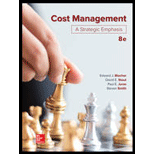
1.
Determine the direct labor rate and efficiency variance for assembly departments.
1.
Explanation of Solution
Compute the labor rate variance for the prior year is as follows:
Compute the efficiency variance for the prior year:
Compute the labor rate variance for the current year:
Compute the efficiency variance for the current year:
Working notes:
Determine the actual and standard labor rate for both the periods:
| Particulars | Prior year | (W.N) | Current year | (W.N) |
| Total actual direct labor hours | $500,000 | $25 × 20,000 | $400,000 | $20 × 20,000 |
| Total standard direct labor hours | $480,000 | $24 × 20,000 | $420,000 | $21 × 20,000 |
| Direct labor rate | $15,000,000 | $30 × 500,000 | $14,400,000 | $36 × 400,000 |
| $14,000,000 | $28 × 500,000 | $14,000,000 | $35 × 400,000 | |
| Standard rate | $13,440,000 | $28 × 480,000 | $14,700,000 | $35 × 420,000 |
Determine the direct labor rate and efficiency variance for testing departments
Compute the labor rate variance for the prior year:
Compute the efficiency variance for the prior year:
Compute the labor rate variance for the current year:
Compute the efficiency variance for the current year:
Working notes:
Determine the actual and standard labor rate of testing department for both the periods:
| Particulars | Prior year | (W.N) | Current year | (W.N) |
| Total actual direct labor hours | $240,000 | $12 × 20,000 | $200,000 | $10 × 20,000 |
| Total standard direct labor hours | $280,000 | $14 × 20,000 | $220,000 | $11 × 20,000 |
| Direct labor rate | $4,800,000 | $20 × 240,000 | $4,800,000 | $24 × 200,000 |
| $5,040,000 | $21 × 240,000 | $5,000,000 | $25 × 200,000 | |
| Standard rate | $5,880,000 | $21× 280,000 | $5,500,000 | $25 × 220,000 |
2.
Determine the partial operational productivity for prior year and current year for assembly department.
2.
Explanation of Solution
Compute the partial operational productivity for prior year:
Compute the partial operational productivity for current year:
Compute the partial operational productivity of for testing department for prior year:
Compute the partial operational productivity of testing department for current year:
3.
Determine the partial financial productivity for prior year and current year for assembly department.
3.
Explanation of Solution
Compute the partial financial productivity for prior year:
Compute the partial financial productivity for current year:
Compute the partial financial productivity of testing department for prior year:
Compute the partial operational productivity of testing department for current year:
4.
Compare and comment results based on two requirements:
4.
Explanation of Solution
| Operational partial productivity | |||
| Particulars | Prior Year | Current year | Changes |
| Assembly | 0.04 | 0.05 | 0.01 F |
| Testing | 0.0833 | 0.1 | 0.0167 F |
| Financial partial productivity | |||
| Particulars | Prior Year | Current year | Changes |
| Assembly | 0.0013 | 0.0014 | 0.0001 F |
| Testing | 0.0042 | 0.0042 | 0 |
The operational partial productivity for both the departments is increased in the current year compared to previous year. The financial partial productivity is also increased compared to testing department.
5.
Explain how the productivity measure differ from variance analyze.
5.
Explanation of Solution
The
Under productivity measures, the productivity of the previous year is determined without adjusting changes occurred during the current year.
Want to see more full solutions like this?
Chapter 16 Solutions
Cost Management
- The equipment has an estimated life of 8 years and an estimated salvage value of $30,000.arrow_forwardPlease provide the correct answer to this general accounting problem using accurate calculations.arrow_forwardLarkson Equipment purchased a conveyor system for $52,000 on January 1, 2019. The system has an expected salvage value of $3,000 and is expected to be used for 200,000 hours over its estimated useful life of 8 years. Actual usage was 22,000 hours in 2019 and 18,500 hours in 2020. Calculate depreciation expense per hour under the units-of-activity method. (Round the answer to 2 decimal places).arrow_forward
- Determine the number of units completedarrow_forwardFranklin Corp. has 25 million shares outstanding and trades at $38 per share. Franklin has net identifiable assets with a book value of $800 million and a fair value of $950 million. Riverdale Investments purchases all of Franklin Corp.'s stock for $48 per share. How much will Riverdale Investments record as goodwill upon acquiring Franklin Corp.?arrow_forwardI need assistance with this financial accounting question using appropriate principles.arrow_forward

 AccountingAccountingISBN:9781337272094Author:WARREN, Carl S., Reeve, James M., Duchac, Jonathan E.Publisher:Cengage Learning,
AccountingAccountingISBN:9781337272094Author:WARREN, Carl S., Reeve, James M., Duchac, Jonathan E.Publisher:Cengage Learning, Accounting Information SystemsAccountingISBN:9781337619202Author:Hall, James A.Publisher:Cengage Learning,
Accounting Information SystemsAccountingISBN:9781337619202Author:Hall, James A.Publisher:Cengage Learning, Horngren's Cost Accounting: A Managerial Emphasis...AccountingISBN:9780134475585Author:Srikant M. Datar, Madhav V. RajanPublisher:PEARSON
Horngren's Cost Accounting: A Managerial Emphasis...AccountingISBN:9780134475585Author:Srikant M. Datar, Madhav V. RajanPublisher:PEARSON Intermediate AccountingAccountingISBN:9781259722660Author:J. David Spiceland, Mark W. Nelson, Wayne M ThomasPublisher:McGraw-Hill Education
Intermediate AccountingAccountingISBN:9781259722660Author:J. David Spiceland, Mark W. Nelson, Wayne M ThomasPublisher:McGraw-Hill Education Financial and Managerial AccountingAccountingISBN:9781259726705Author:John J Wild, Ken W. Shaw, Barbara Chiappetta Fundamental Accounting PrinciplesPublisher:McGraw-Hill Education
Financial and Managerial AccountingAccountingISBN:9781259726705Author:John J Wild, Ken W. Shaw, Barbara Chiappetta Fundamental Accounting PrinciplesPublisher:McGraw-Hill Education





